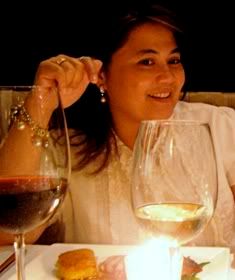 Dinner last night, Thursday, 25th June 2009, was at Sala Restaurant with Apple. My wife and she have been close friends, schoolmates and carpool mates since their elementary school days. Over the many years, I , as well, have grown quite close to her and Rocky - her fellow foodie/wino/soulmate, as we share the same passions. Though we get to see each other only a few times a year since they and their kids live in Hillsborough, Ca, we always make it a point to get together for some good wine and food whenever they are in town.
Dinner last night, Thursday, 25th June 2009, was at Sala Restaurant with Apple. My wife and she have been close friends, schoolmates and carpool mates since their elementary school days. Over the many years, I , as well, have grown quite close to her and Rocky - her fellow foodie/wino/soulmate, as we share the same passions. Though we get to see each other only a few times a year since they and their kids live in Hillsborough, Ca, we always make it a point to get together for some good wine and food whenever they are in town.Rocky, unfortunately couldn't make it this trip and Apple brought only one of her children along. Since she is here for a relatively short while and, naturally, has to spend time with her folks, my wife and I eventually decided that this dinner just be for us three to be able to spend quality time with her.
Apple was well-prepared for the evening, having spent time in the gym and treadmill earlier in the day to be able to indulge without remorse. She and my wife immediately chose the Degustacion Menu, while I, having recently had the same thing, opted for my usual starter of Twice Baked Soufflé of Prawns and Feta Cheese with Dill and the Sous-Vide Squab with Seared Foie Gras, Horseradish Potato Purée and Port Wine Jus for my main course.
Our wines for the evening were Burgundies, both from the Côte de Beaune, by Louis Jadot, both sourced from Bacchus Int'l.
 I had the young 2004 Jadot Domaine Duc de Magenta Chassagne-Montrachet Premier Cru Morgeot Clos de la Chapelle decanted to breathe in a bucket of mildly iced water for around an hour before serving. The 1999 Jadot Corton-Pougets Grand Cru was just left opened for 45 minutes in the bottle - no decanting.
I had the young 2004 Jadot Domaine Duc de Magenta Chassagne-Montrachet Premier Cru Morgeot Clos de la Chapelle decanted to breathe in a bucket of mildly iced water for around an hour before serving. The 1999 Jadot Corton-Pougets Grand Cru was just left opened for 45 minutes in the bottle - no decanting.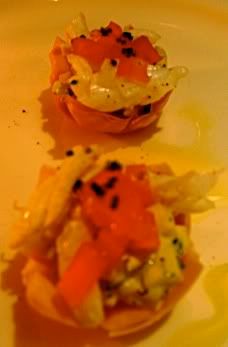
Amuse bouche of crab and tomatoes arranged like flower petals in a little tart
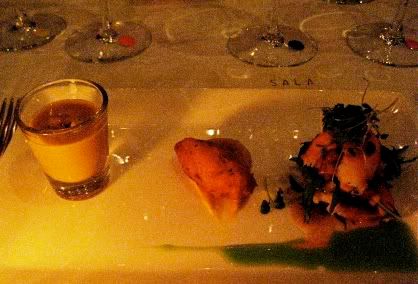
Trio of Corn and Sweet Shrimp Bisque, Sweet Shrimp Beignette with Corn Purée and Sweet Shrimp and Corn Salad
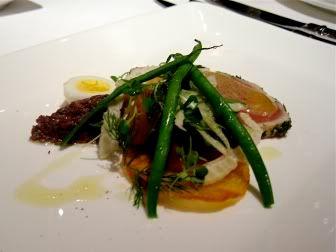
Salad of rare tuna and some greens with quail egg
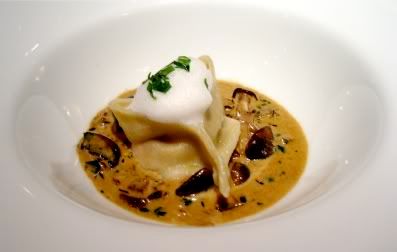
Quail Bacon Sage Tortelloni with Mushroom Fricasee and Truffle Oil
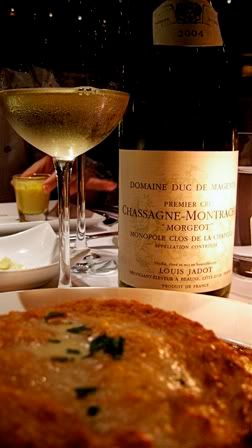 2004 Maison Louis Jadot Chassagne-Montrachet Premier Cru Morgeot Monopole Clos de la Chapelle Domaine Duc de Magenta - The grapes that go into making this wine come from the monopole (single owner) enclosed vineyard ("clos") named Clos de la Chapelle located in the premier cru climat of Morgeot within the Chassagne-Montrachet appellation in the Côte de Beaune. While Domaine Duc de Magenta is the sole owner of Clos de la Chapelle, the produce thereof is, by long-term contract, under exclusive vinification and distribution of Maison Louis Jadot. The premier cru Morgeot is known to yield the most masculine of the whites of Chassagne-Montrachet.
2004 Maison Louis Jadot Chassagne-Montrachet Premier Cru Morgeot Monopole Clos de la Chapelle Domaine Duc de Magenta - The grapes that go into making this wine come from the monopole (single owner) enclosed vineyard ("clos") named Clos de la Chapelle located in the premier cru climat of Morgeot within the Chassagne-Montrachet appellation in the Côte de Beaune. While Domaine Duc de Magenta is the sole owner of Clos de la Chapelle, the produce thereof is, by long-term contract, under exclusive vinification and distribution of Maison Louis Jadot. The premier cru Morgeot is known to yield the most masculine of the whites of Chassagne-Montrachet.For those new to the wines of Burgundy, the Côte de Beaune is more famous for producing white wines (chardonnay), including the most sought-after grand cru Montrachet, the vineyards of which straddle the villages of Chassagne-Montrachet and Puligny-Montrachet.
This is a rather self-possessed, austere Morgeots, likely due to the vintage. It is initially a bit tight, presenting clean, dry, highly focused, slightly floral white fruit, apple, steel, white minerality with hints of spicy/toasty oak and leesiness on a medium body. As it warmed a bit in the glass, the wine fleshed out, gaining a little heft and breadth mid-mouth and through to the finish. In so doing, it showed more depth and concentration in its fruit. Over-all, it has admirable purity, balance and restraint - a classy performance.
The main courses:
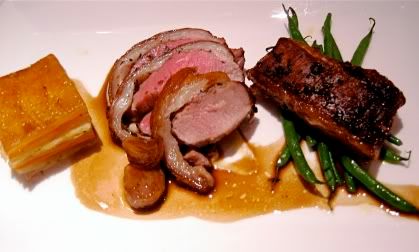
Roast Lamb Shortloin and Lamb Shortribs Confit with Root Vegetable Pâve and Shallot Jus for the ladies with...
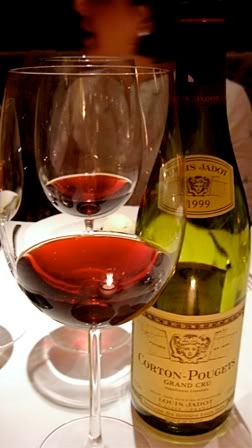
1999 Jadot Corton-Pougets Grand Cru
I enjoyed this with my Sous-Vide Squab with Seared Foie Gras, Horseradish Potato Purée and Port Wine Jus.
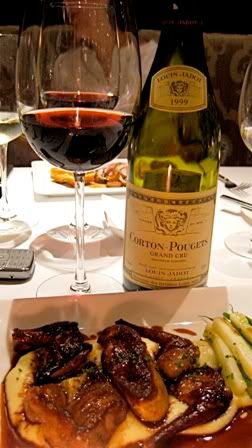 1999 Jadot Corton-Pougets Grand Cru - I first tried this from Vancouver Vince over a post golf dinner at home on the 13th May 2009. I liked it a lot, so got some for Apple to try. As luck would have it, she is currently enjoying pinot noir based wines after spending a weekend at a recent Pigs & Pinot festival - so my choice of red was most appropriate. My previous notes were as follows:
1999 Jadot Corton-Pougets Grand Cru - I first tried this from Vancouver Vince over a post golf dinner at home on the 13th May 2009. I liked it a lot, so got some for Apple to try. As luck would have it, she is currently enjoying pinot noir based wines after spending a weekend at a recent Pigs & Pinot festival - so my choice of red was most appropriate. My previous notes were as follows:From Jadot's own south-eastern exposed vineyard situated on the Rognon de Corton (literally, the "Corton kidney"), just below the vineyards of Corton-Charlemagne.
A bit reticent, initially, after around 15 minutes in the glass, this attractive dark red wine started opening up with sweetly-spiced raspberry, cherry and fine cedar - eventually developing into a nicely perfumed bouquet.This wine was alluringly, seductively feminine in character, with very notable finesse - from the attack to finish, there is definitiveness, but elegantly understated. In the mouth, notes of dried cranberry, red beet and a whisper of violets are intricately intertwined with the mirrored sweetly spiced red fruit/berry aromas - making for a very enjoyable wine indeed.
I can add now, since the wine had more aeration in bottle and glass this time, that it exhibited more openly the power, breadth, body and push expected of grand cru status and more depth in its deep, pure and well-defined cherry and raspberry flavors - but all in a polished and poised manner.
 We finished the evening with a lot of stories, desserts (of which I forgot to take pictures, I had the Mango & Passion Fruit Pavlova), and cups of coffee. It was really great catching up with Apple again. Next time, hopefully, Rocky will also be around to share in the fun.
We finished the evening with a lot of stories, desserts (of which I forgot to take pictures, I had the Mango & Passion Fruit Pavlova), and cups of coffee. It was really great catching up with Apple again. Next time, hopefully, Rocky will also be around to share in the fun.




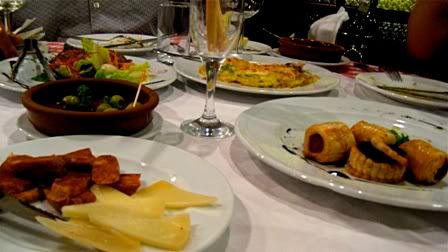
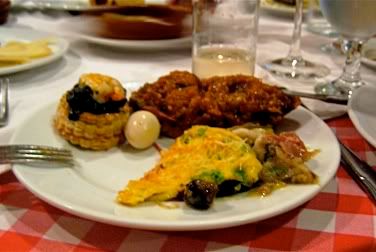 With the Kokotxas de Bacalao al Pilpil, I had a couple of glasses of...
With the Kokotxas de Bacalao al Pilpil, I had a couple of glasses of...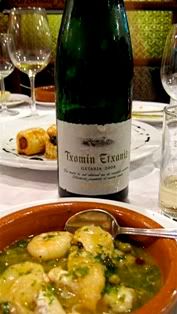

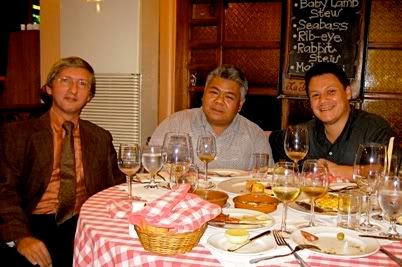
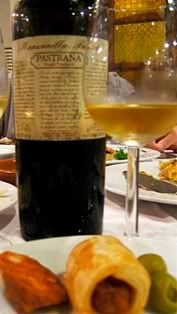


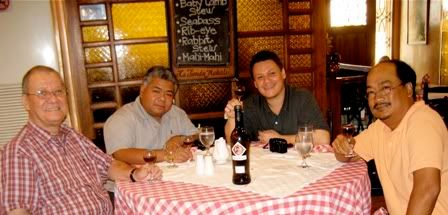
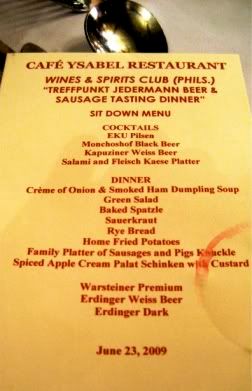 My wife and I arrived just a few minutes past 7:30. Aside from the evening's hosts and the usual suspects, my brother, T, and his wife, C, were already there enjoying huge platters of Salami and Fleische Kaese...
My wife and I arrived just a few minutes past 7:30. Aside from the evening's hosts and the usual suspects, my brother, T, and his wife, C, were already there enjoying huge platters of Salami and Fleische Kaese...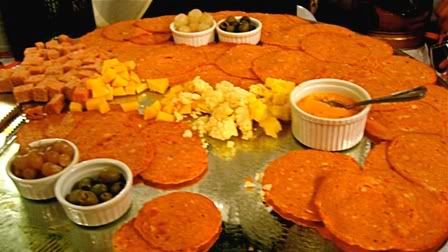 ...and the initial salvo of 3 German beers.
...and the initial salvo of 3 German beers.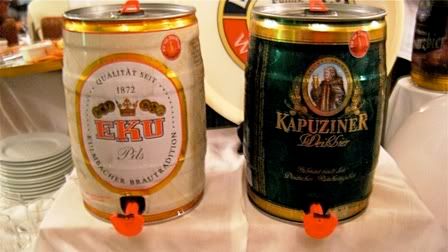
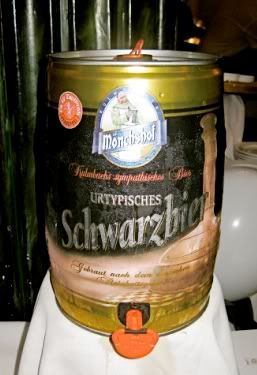
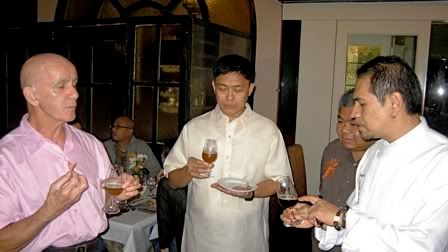
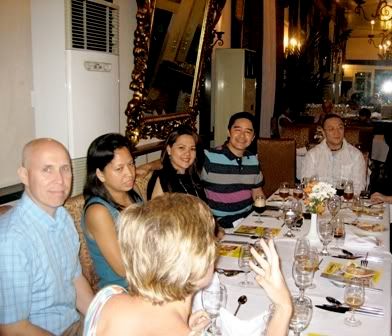
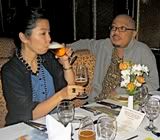
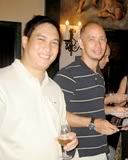

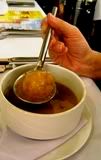
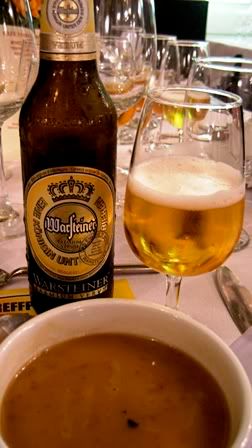 Warsteiner Premium Verum, which happens to be a beer we keep in stock at home. Just under medium in body, mildly creamy, nicely clean, with a light malt sweetness towards the back of the mouth. Very easy to drink. My teenagers like this a lot, and I can understand why.
Warsteiner Premium Verum, which happens to be a beer we keep in stock at home. Just under medium in body, mildly creamy, nicely clean, with a light malt sweetness towards the back of the mouth. Very easy to drink. My teenagers like this a lot, and I can understand why.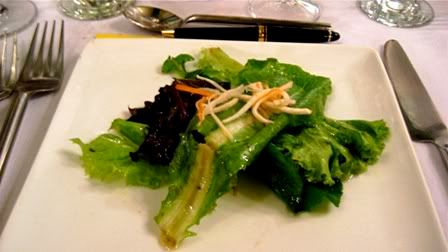 Next was a simple, refreshing Green Salad which I made short work of knowing that this would likely be the healthiest course of the night. The following dishes were served together, family style and in most generous amounts, much more than we could possibly finish.
Next was a simple, refreshing Green Salad which I made short work of knowing that this would likely be the healthiest course of the night. The following dishes were served together, family style and in most generous amounts, much more than we could possibly finish.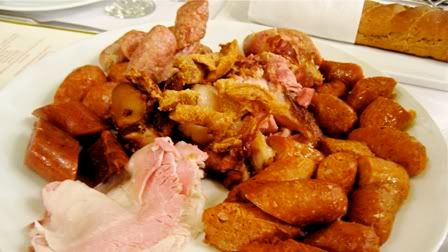
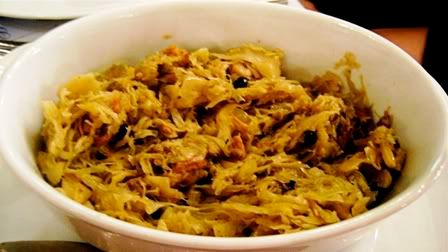
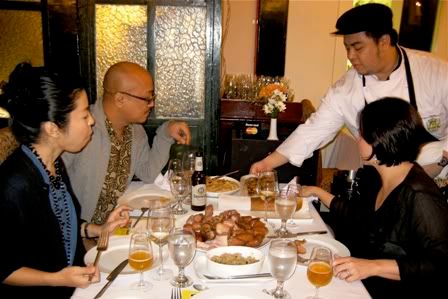
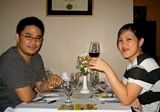
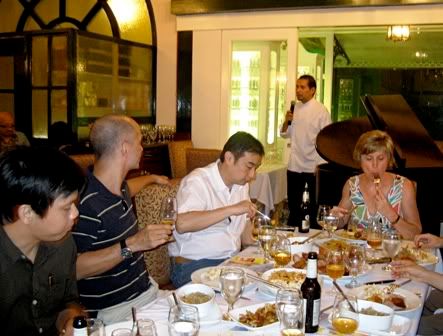 I also noted that J-Lab and Nico probably had the same thing on their minds....
I also noted that J-Lab and Nico probably had the same thing on their minds....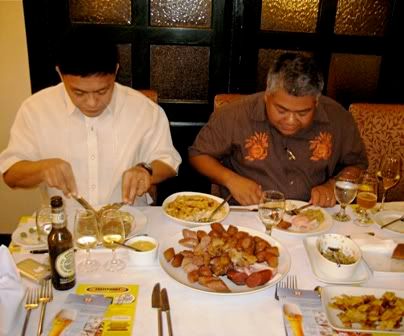 It was good to see Gene actually eating. It seems to me he is always bustling about and, save for that evening, I don't recall ever seeing him sit down and actually take sustenance.
It was good to see Gene actually eating. It seems to me he is always bustling about and, save for that evening, I don't recall ever seeing him sit down and actually take sustenance.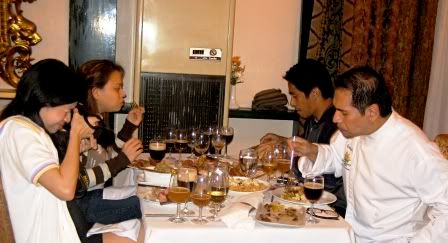 The sponsors oversaw the event from their table. I must note that the young Meynet did his parents proud - a young gentleman politely and efficiently helping with the evening, distributing the give-away bottle-openers and pens.
The sponsors oversaw the event from their table. I must note that the young Meynet did his parents proud - a young gentleman politely and efficiently helping with the evening, distributing the give-away bottle-openers and pens.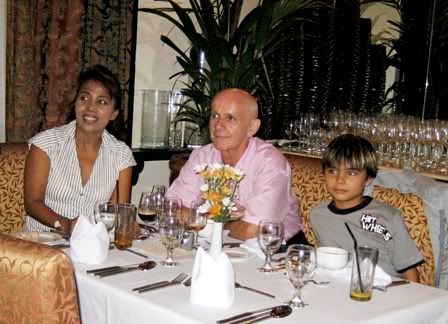 I enjoyed this hearty meal with two different beers.
I enjoyed this hearty meal with two different beers. Erdinger Weiss Beer, lightly fruity but nicely dry, I tasted hints of banana and citrus with a very slight, appetizing yeasty bitterness at the end. The finish was not long but quite clean. Very easy to drink.
Erdinger Weiss Beer, lightly fruity but nicely dry, I tasted hints of banana and citrus with a very slight, appetizing yeasty bitterness at the end. The finish was not long but quite clean. Very easy to drink. ...who said a few words about his products and thanked everyone for attending, though it was us who should have been thanking him for the evening.
...who said a few words about his products and thanked everyone for attending, though it was us who should have been thanking him for the evening.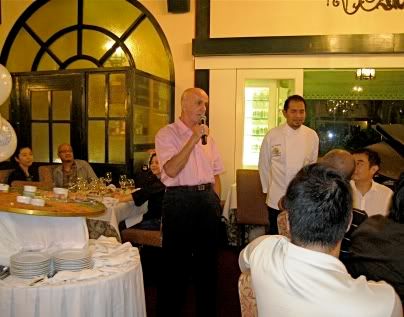 Dessert was a Spiced Apple cream Palat Schinken with Custard and Home-Made Chocolate Ice Cream on the Side.
Dessert was a Spiced Apple cream Palat Schinken with Custard and Home-Made Chocolate Ice Cream on the Side.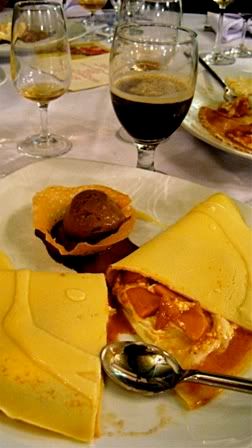 My brother and I couldn't help but try the dessert, especially the delicious home-made chocolate ice cream, with yet another glass each of the Mönchshof Black Beer which Gene expertly coaxed out of the now reluctant keg. The beer's rich dark chocolate ran hand in glove with the ice cream. Chocolate beer and chocolate ice cream - it may sound strange, but, what can I say? Beer newbie and probably Philistine that I am, I enjoyed the hell out of them together.
My brother and I couldn't help but try the dessert, especially the delicious home-made chocolate ice cream, with yet another glass each of the Mönchshof Black Beer which Gene expertly coaxed out of the now reluctant keg. The beer's rich dark chocolate ran hand in glove with the ice cream. Chocolate beer and chocolate ice cream - it may sound strange, but, what can I say? Beer newbie and probably Philistine that I am, I enjoyed the hell out of them together.

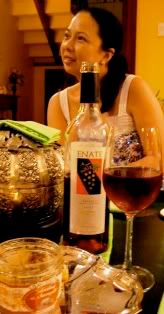
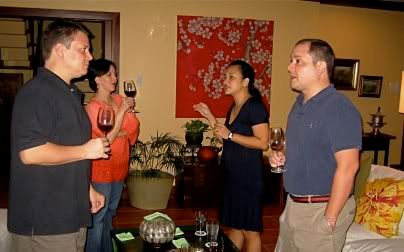
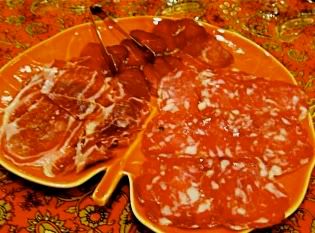
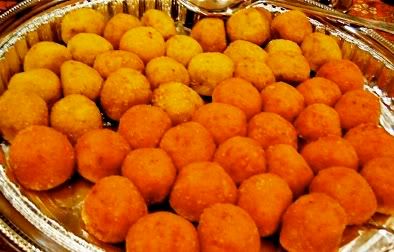
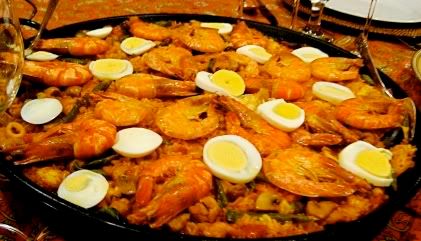
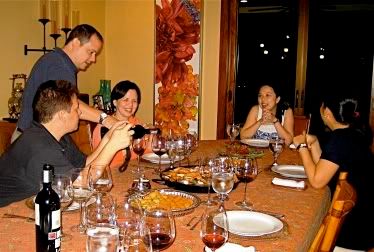
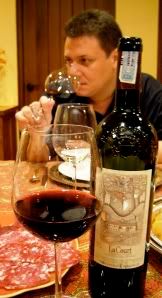

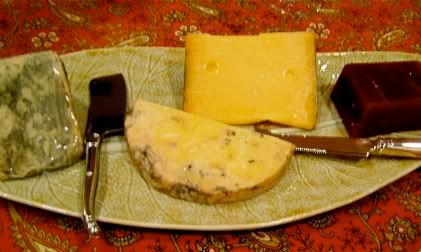
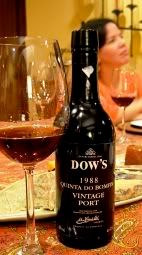
 We then lingered over last pours from the bottles and, at around midnight, took our respective leaves, thanking our hosts for such a relaxing and most enjoyable evening.
We then lingered over last pours from the bottles and, at around midnight, took our respective leaves, thanking our hosts for such a relaxing and most enjoyable evening.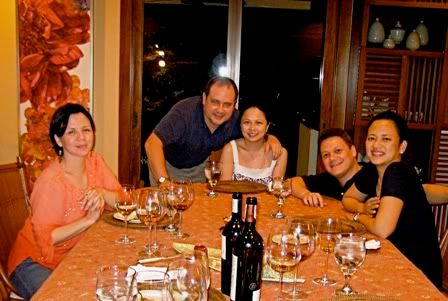 Oh, and congratulations to Rene and Aimee, at least now I can already openly say it.
Oh, and congratulations to Rene and Aimee, at least now I can already openly say it.